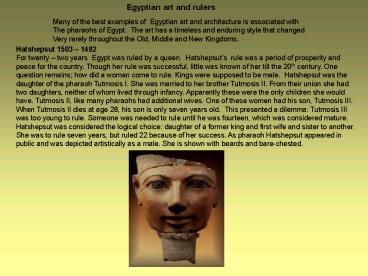Egyptian art and rulers PowerPoint PPT Presentation
1 / 9
Title: Egyptian art and rulers
1
Egyptian art and rulers
Many of the best examples of Egyptian art and
architecture is associated with The pharaohs of
Egypt. The art has a timeless and enduring style
that changed Very rarely throughout the Old,
Middle and New Kingdoms.
Hatshepsut 1503 1482 For twenty two years
Egypt was ruled by a queen. Hatshepsuts rule
was a period of prosperity and peace for the
country. Though her rule was successful, little
was known of her till the 20th century. One
question remains how did a woman come to rule.
Kings were supposed to be male. Hatshepsut was
the daughter of the pharaoh Tutmosis I. She was
married to her brother Tutmosis II. From their
union she had two daughters, neither of whom
lived through infancy. Apparently these were the
only children she would have. Tutmosis II, like
many pharaohs had additional wives. One of these
women had his son, Tutmosis III. When Tutmosis II
dies at age 28, his son is only seven years old.
This presented a dilemma Tutmosis III was too
young to rule. Someone was needed to rule until
he was fourteen, which was considered mature.
Hatshepsut was considered the logical choice
daughter of a former king and first wife and
sister to another. She was to rule seven years,
but ruled 22 because of her success. As pharaoh
Hatshepsut appeared in public and was depicted
artistically as a male. She is shown with beards
and bare-chested.
2
Hatshepsut had myths written declaring that
while her outer self was female, her true self
was male. The people knew the king was a woman,
but due to the continued annual flooding of the
Nile, it was felt that the gods desired that she
rule. Life was good so there was no call to
interrupt her reign.
Where was Tutmosis III during this period?
He was apparently constantly shifted to various
military forts to train. Tutmosis III was not
happy his aunt/ stepmother ha taken his place,
but Hatshepsut was too powerful to oppose during
her life. Tutmosis III would have to gain his
revenge at a later time.
Hatshepsut dressed as Pharoah, including being
bare Chested. Breasts are depicted in
understated fashion.
3
Deir El Bahri This is the funeral temple of
Hatshepsut. It consisted of three stories. On
the second level the rooms are carved 108 feet
into the cliff face. On the second level there
were 30 statues of Hatshpsut dress as the gods.
The reason the temple is in this condition is
that after her death Tuthmosis III had his
soldiers Attack and damage the temple. The
statues were smashed and placed in a pit. Her
image and name was scratched off the walls.
Hatshepsuts body has never been recovered. It is
also believed that later male rulers had the
temple damaged as well. Throughout Egypt her
statues were defaced. At the Temple of Luxor were
the images of the pharaoh lineage were incised
Hatshepsut image is carefully chiseled out.
Deir El Bahri in the 1990s with destroyed
portions
Recent restoration of temple. Third level is
modern.
Defaced statue of Hatshepsut
4
Akhenaten and Tutankamun family tree
5
(No Transcript)
6
Pharaoh Akhenaten Akhenatens unusual
appearance was caused by marfans syndrome A bone
and tissue disease. It gave him a long face, and
female characteristics such as prominent
breasts And wide hips. Akhenaton will change the
art styles of Egypt. All citizens had to make
their images look like him.
Akhenaten video clip
7
Nerfertiti was the wife and sister of Akhenaton.
Her marfans symptoms were not as severe as her
brothers. Facially She look very normal, it is
the back of her skull where the disease shows up.
It is believed that she adopted this unusual
Headdress to cover her affliction. Recently a
mummy was found that some believe to be
Nefertiti. The mummy is damaged, But the skull
does show the elongation of Marfans syndrome.
8
King Tut view of first wooden coffin
King Tut second gold plated coffin
9
Gold Mummy Mask of King Tut
Gold inner coffin of king Tut

